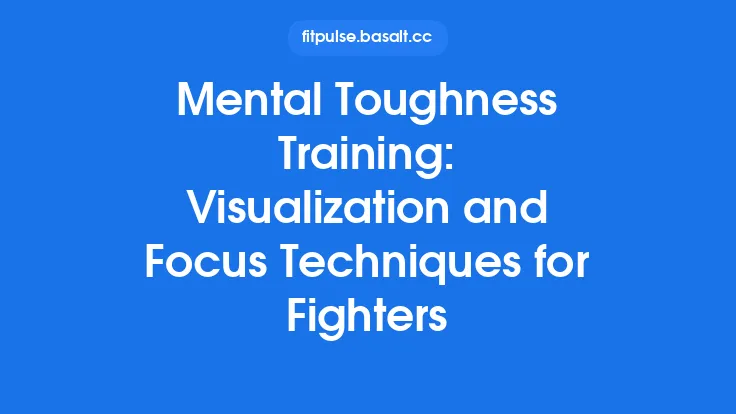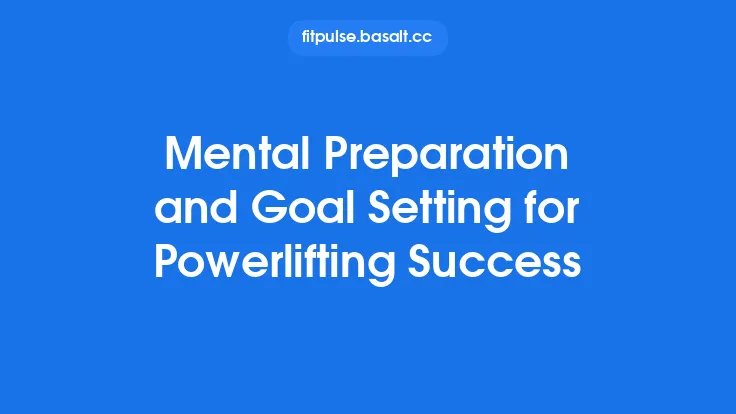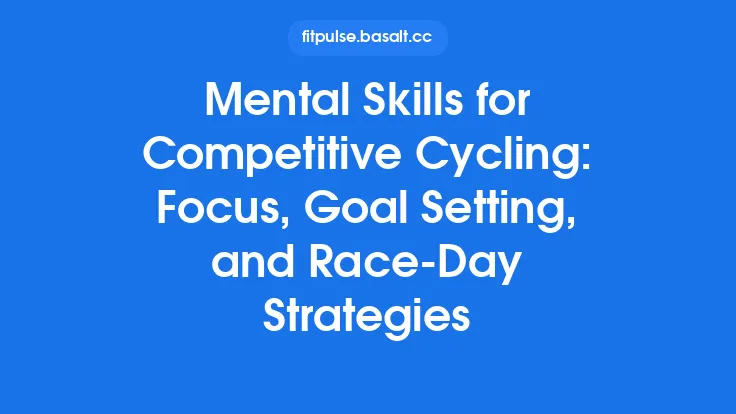Competitive swimming is as much a mental battle as it is a physical one. While countless hours are spent perfecting stroke mechanics, building aerobic capacity, and fine‑tuning race strategies, the athlete’s inner dialogue, focus, and emotional regulation often determine whether a training cycle culminates in a podium finish or a missed opportunity. This article delves into the science‑backed mental preparation techniques that elite swimmers use to sharpen concentration, manage stress, and sustain confidence throughout a season. By integrating these practices into daily routines, swimmers can develop a resilient mindset that supports peak performance when the starting gun fires.
Understanding the Mental Demands of Competitive Swimming
Competitive swimming presents a unique psychological landscape. Races are short, intense bursts of effort that demand split‑second decision‑making, yet the preparation for each event can span weeks or months. Key mental challenges include:
- High arousal pressure – The need to explode out of the blocks while staying composed.
- Rapid transition – Moving from a warm‑up routine to race intensity within minutes.
- Repetitive stress – Frequent meets and time trials can erode motivation and increase burnout risk.
- External scrutiny – Coaches, teammates, and spectators often amplify performance expectations.
Recognizing these stressors is the first step toward building a mental toolkit that can neutralize their impact.
Goal Setting and Planning
Effective mental preparation begins with clear, structured goals. Research in sport psychology distinguishes between outcome goals (e.g., “win the 200 m freestyle”), performance goals (e.g., “break 1:48.00”), and process goals (e.g., “maintain a steady breathing pattern on the third 50 m”). Process goals are especially powerful because they focus attention on controllable elements.
SMART framework – Specific, Measurable, Achievable, Relevant, Time‑bound – provides a practical template:
- Specific – “Improve turn speed by 0.15 s on the 100 m freestyle.”
- Measurable – Use a stopwatch or video analysis to track progress.
- Achievable – Ensure the target aligns with current training load and physiological capacity.
- Relevant – Connect the goal to larger competition objectives.
- Time‑bound – Set a deadline, such as “by the next regional meet.”
Document goals in a training journal, review them weekly, and adjust as needed. This habit reinforces accountability and creates a roadmap for mental focus.
Visualization and Mental Rehearsal
Visualization (or imagery) is a cornerstone of elite swimmer preparation. By mentally simulating race scenarios, athletes activate neural pathways similar to those used during actual swimming, enhancing motor pattern recall and confidence.
Types of imagery:
- Internal (first‑person) – Imagine seeing through your own eyes, feeling the water’s resistance, the pull of each stroke.
- External (third‑person) – Picture yourself from a spectator’s perspective, observing body position and technique.
- Kinesthetic – Focus on the sensation of muscle contraction, breathing rhythm, and the “feel” of a perfect turn.
Effective practice:
- Set the scene – Include details such as pool temperature, lighting, crowd noise, and the sound of the starter’s pistol.
- Sequence the race – Start from the dive, progress through each lap, and finish with the touchpad reaction.
- Incorporate emotions – Feel the excitement, the pressure, and the calm after a strong finish.
- Repeat regularly – 5–10 minutes of imagery 3–4 times per week yields measurable performance gains.
Athletes who combine visual and kinesthetic cues report smoother transitions from warm‑up to race pace and reduced pre‑race anxiety.
Arousal Regulation and Pre‑Race Routines
Swimmers must strike an optimal arousal zone—neither under‑stimulated (leading to sluggish starts) nor over‑stimulated (causing premature fatigue). The Inverted-U hypothesis suggests performance peaks at moderate arousal levels, with declines at extremes.
Techniques to modulate arousal:
- Controlled breathing – Box breathing (4‑4‑4‑4 seconds) lowers heart rate and steadies focus.
- Progressive muscle relaxation (PMR) – Systematically tense and release muscle groups to reduce physical tension.
- Music cues – A short, high‑tempo playlist can elevate energy before sprint events; slower, melodic tracks can calm before distance races.
- Pre‑race checklist – A consistent sequence (e.g., equipment check → warm‑up → visualization → breathing routine) signals the brain that it is time to perform, reducing uncertainty.
A personalized pre‑race routine, rehearsed in practice, becomes a mental trigger that automatically brings arousal to the desired level.
Mindfulness and Focus Training
Mindfulness cultivates present‑moment awareness without judgment, a skill that translates directly to the pool where distractions (e.g., a competitor’s splash, a sudden crowd cheer) can derail concentration.
Simple mindfulness drills for swimmers:
- “Water‑scan” meditation – While standing at the pool edge, close eyes and mentally scan the sensations of the water: temperature, sound, the smell of chlorine. This anchors attention to the immediate environment.
- Focused attention laps – During a warm‑up set, choose a single cue (e.g., the sound of the splash) and bring attention back to it each time the mind wanders.
- Three‑minute breathing break – After a high‑intensity set, sit on the pool deck, inhale for a count of 5, exhale for 5, repeat for three minutes. This practice clears mental clutter and improves recovery.
Regular mindfulness practice has been linked to lower perceived stress, improved reaction time, and enhanced decision‑making under pressure.
Self‑Talk and Cognitive Restructuring
The internal dialogue can either empower or sabotage performance. Positive self‑talk (e.g., “I’m strong, I’ve trained for this”) reinforces confidence, while negative self‑talk (e.g., “I always choke at the finish”) erodes it.
Steps to optimize self‑talk:
- Awareness – Keep a log of thoughts that arise before, during, and after races.
- Challenge – Question the evidence for each negative statement (“Do I really always choke?”).
- Replace – Formulate a realistic, encouraging alternative (“I have a solid finish plan; I will execute it”).
- Rehearse – Use the replacement phrase during visualization and pre‑race routines.
Cognitive restructuring, a core component of cognitive‑behavioral therapy, helps swimmers develop a resilient narrative that supports performance under stress.
Building Resilience and Coping with Setbacks
Even the most prepared swimmers encounter setbacks—missed qualifying times, injuries, or unexpected race outcomes. Resilience is the capacity to bounce back, learn, and maintain motivation.
Resilience‑building strategies:
- Growth mindset – View challenges as opportunities for development rather than fixed limitations.
- Reflective debriefs – After each meet, write a brief analysis focusing on what worked, what didn’t, and actionable adjustments.
- Social support – Cultivate a network of teammates, coaches, and family who provide constructive feedback and emotional encouragement.
- Stress‑inoculation training – Simulate high‑pressure scenarios in practice (e.g., “race‑day” mock meets) to habituate the nervous system to competition stress.
By normalizing setbacks as part of the performance cycle, swimmers reduce fear of failure and sustain long‑term progress.
Team Dynamics and Coach Communication
Although swimming is often perceived as an individual sport, the surrounding team environment heavily influences mental readiness. Clear, supportive communication with coaches and teammates can alleviate anxiety and reinforce confidence.
Best practices:
- Goal alignment meetings – Schedule brief quarterly sessions where swimmers and coaches review personal and team objectives.
- Feedback framing – Use the “sandwich” method (positive → constructive → positive) to keep critiques actionable and morale high.
- Peer mentorship – Pair younger swimmers with experienced teammates for shared mental‑skill drills and experience exchange.
- Conflict resolution – Address interpersonal issues promptly through open dialogue or mediated discussion to prevent lingering tension.
A cohesive team culture creates a psychological safety net that allows athletes to focus on performance rather than interpersonal stressors.
Sleep, Recovery, and Mental Freshness
Cognitive function, emotional regulation, and reaction time are all contingent on adequate sleep and recovery. Chronic sleep deprivation impairs memory consolidation, which is essential for retaining visualization scripts and tactical cues.
Sleep hygiene tips for swimmers:
- Consistent schedule – Aim for 7–9 hours of sleep, going to bed and waking at the same times daily, even on travel days.
- Pre‑sleep routine – Dim lights, limit screen exposure, and incorporate a brief relaxation exercise (e.g., progressive breathing) 30 minutes before bed.
- Napping strategy – Short (20‑30 minute) naps can boost alertness without disrupting nighttime sleep, especially after early‑morning sessions.
- Recovery modalities – Incorporate low‑intensity activities (e.g., gentle yoga, light stretching) on rest days to promote mental relaxation and reduce rumination.
Prioritizing restorative sleep ensures the brain is primed for both learning new mental skills and executing them under pressure.
Integrating Mental Skills into Daily Practice
Mental preparation should not be an isolated activity; it must be woven into the fabric of each training day.
Sample integration plan:
| Time of Day | Activity | Mental Skill Emphasis |
|---|---|---|
| Morning warm‑up | 800 m easy swim | Focused attention on breath and stroke feel |
| Mid‑session | 10 × 100 m at race pace | Self‑talk cues (“strong, smooth, powerful”) |
| Post‑set | 5‑minute cool‑down | Mindful body scan, release tension |
| Evening | 10 minutes visualization | Full race rehearsal with sensory detail |
| Before bed | Journaling | Reflective debrief and goal review |
By pairing physical sets with specific mental tasks, swimmers reinforce neural pathways that link technique, effort, and mindset.
Assessing Progress and Adjusting Strategies
Just as physical performance is tracked through times and splits, mental skill development benefits from systematic assessment.
Tools for monitoring:
- Psychological questionnaires – Instruments such as the Competitive State Anxiety Inventory‑2 (CSAI‑2) or the Sport Motivation Scale provide quantitative snapshots of anxiety, confidence, and motivation.
- Performance logs – Record pre‑race arousal levels, self‑talk statements, and perceived focus; compare against race outcomes.
- Coach‑athlete check‑ins – Monthly briefings to discuss mental skill usage, challenges, and modifications.
When data reveal stagnation (e.g., persistent high anxiety before finals), adjust the approach—perhaps increasing mindfulness sessions, revisiting goal specificity, or incorporating additional relaxation techniques.
By systematically applying these mental preparation techniques, competitive swimmers can cultivate a robust psychological foundation that complements their physical training. The synergy of a well‑conditioned body and a resilient mind not only enhances race day performance but also promotes long‑term enjoyment and sustainability in the sport. Embrace the mental game as an integral part of every practice, and watch the water transform from a mere arena of physical effort into a stage where confidence, focus, and composure lead to victory.





